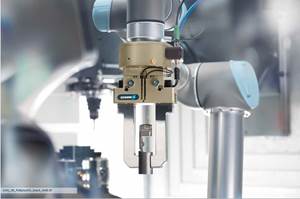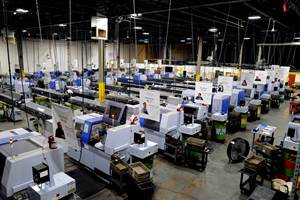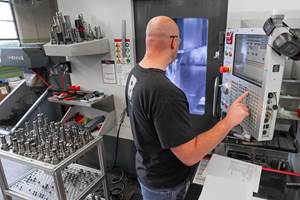Manufacturing Cells Can Eliminate Wastes
A manufacturing cell is an efficient grouping of all the resources required to manufacture a product. These resources, which usually include people, supplies, machines, tools and other production equipment, are arranged in close proximity to enhance communication and allow everyone to see what is going on at all times.
Share






A manufacturing cell is an efficient grouping of all the resources required to manufacture a product. These resources, which usually include people, supplies, machines, tools and other production equipment, are arranged in close proximity to enhance communication and allow everyone to see what is going on at all times.
Cellular manufacturing is a tried and true process that has reduced product costs, while improving leadtimes and quality. Cells have prospered because they work, and they work in almost any type of manufacturing environment. One reason cells are successful is that they often eliminate many of the wastes inherent in a typical manufacturing operation. Let’s look at some of these wastes.
Overproduction: Overproduction means making more than the next operation can use immediately. A manufacturing cell helps eliminate the waste of overproduction by making it easier to produce only what is needed. All operations are in close proximity, and balancing the steps in the production process is simplified. In a cellular arrangement, one operator can complete multiple operations, which may improve the balance of work and simplify product flow.
Excess inventory: Excess inventory is a result of the waste of overproduction. It is also one of the costliest of all manufacturing wastes. Manufacturing cells address the issue of inventory waste in a number of ways. First, by balancing the work and instructing operators not to exceed what the next person can handle, the work-in-process inventory is reduced. By the nature of the cell layout, excess inventory cannot be tolerated because there is no place to put it. Manufacturing cells solve the vacant space paradox, which says the amount of vacant space is inversely proportional to the amount of time it is vacant.
Overprocessing: Processing a part more than is required to make it function properly is another form of waste. Cells address the waste of over processing through close proximity of all processes and the strategy of only making what can be used. Unnecessary processes such as packing and unpacking are eliminated because handling is reduced, and that which remains poses little risk of damage. Parts in the cells are processed sooner, so any of the other product protection processes can also be eliminated. The close proximity of all the operations makes it easier to identify the processes that are not adding value to the product.
Motion: There is significant wasted motion in a typical manufacturing process. This often results from a poorly organized work area. By putting everything together in a manufacturing cell, wasted motion can be reduced, if not eliminated entirely. Eliminating travel to other areas to get parts is an obvious improvement, but what cannot be underestimated is the reduction of motion within an individual process. With a well-designed cellular operation, motion shifts from non-value added to value added. When emphasis is placed on conveniently locating everything that operators need to do their jobs, much wasted motion is eliminated.
Waiting: One of the most common causes of waiting is an unbalanced workload. Manufacturing cells can reduce waiting by supporting more synchronized flow. With all the required resources grouped closely together, synchronized product flow is easier. Worker flexibility within the cell will also help reduce waiting time because operators can help others when they are not busy.
Transportation: Transporting a part through the shop is a wasted effort. A manufacturing cell can reduce part transportation because the close proximity of the cell’s resources makes part transportation almost non-existent. As a result, material handling equipment can be reduced or eliminated altogether.
Defects: Defects are often the result of all of the wastes previously mentioned, but they can also result from poor process control, poor product designs, improperly selected machines and poor communication of requirements. Cells may not completely eliminate defects, but they will allow those that do occur to be identified faster, while allowing for expedited corrective action. With close proximity of resources, defects are communicated to all involved parties immediately, so no more than one defect should be produced at a time.
Order tracking: Although not generally recognized as a waste, order tracking in manufacturing operations is quite time- consuming and not a value-added activity. A manufacturing cell offers simplified scheduling. Because all operations are grouped together, the order can be fed to the cell on a first-in-first-out basis, and tracking of the status of orders becomes a visual check. Complex computer systems are typically not needed to schedule the cell. Many companies use simple scheduling boards that the entire team can view.
Related Content
Lean Approach to Automated Machine Tending Delivers Quicker Paths to Success
Almost any shop can automate at least some of its production, even in low-volume, high-mix applications. The key to getting started is finding the simplest solutions that fit your requirements. It helps to work with an automation partner that understands your needs.
Read MoreUsing Jaws as Grippers Enables Flexible, Low-Cost Automation
VersaBuilt’s automation systems significantly boosted Innovative Fabrication’s revenue. In return, the shop has helped VersaBuilt optimize its products.
Read MoreInside the Premium Machine Shop Making Fasteners
AMPG can’t help but take risks — its management doesn’t know how to run machines. But these risks have enabled it to become a runaway success in its market.
Read MoreMedical Shop Performs Lights-Out Production in Five-Axes
Moving to five-axis machining enabled this shop to dramatically reduce setup time and increase lights-out capacity, but success relied on the right combination of workholding and automation.
Read MoreRead Next
Last Chance! 2025 Top Shops Benchmarking Survey Still Open Through April 30
Don’t miss out! 91ÊÓƵÍøÕ¾ÎÛ's Top Shops Benchmarking Survey is still open — but not for long. This is your last chance to a receive free, customized benchmarking report that includes actionable feedback across several shopfloor and business metrics.
Read MoreAMRs Are Moving Into Manufacturing: 4 Considerations for Implementation
AMRs can provide a flexible, easy-to-use automation platform so long as manufacturers choose a suitable task and prepare their facilities.
Read MoreMachine Shop MBA
Making Chips and 91ÊÓƵÍøÕ¾ÎÛ are teaming up for a new podcast series called Machine Shop MBA—designed to help manufacturers measure their success against the industry’s best. Through the lens of the Top Shops benchmarking program, the series explores the KPIs that set high-performing shops apart, from machine utilization and first-pass yield to employee engagement and revenue per employee.
Read More



















